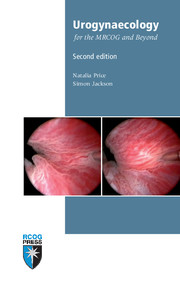Book contents
- Frontmatter
- Contents
- Preface
- Abbreviations
- 1 Applied anatomy and physiology of the lower urinary tract
- 2 Definition and prevalence of urinary incontinence
- 3 Initial assessment of lower urinary tract symptoms
- 4 Further investigation of lower urinary tract symptoms
- 5 Management of stress urinary incontinence
- 6 Management of overactive bladder syndrome
- 7 Recurrent urinary tract infection
- 8 Haematuria
- 9 Painful bladder syndrome and interstitial cystitis
- 10 Pregnancy and the renal tract
- 11 Ageing and urogenital symptoms
- 12 Fistulae and urinary tract injuries
- 13 Pelvic organ prolapse
- 14 Colorectal disorders
- 15 Obstetric anal sphincter injuries
- Index
6 - Management of overactive bladder syndrome
Published online by Cambridge University Press: 05 July 2014
- Frontmatter
- Contents
- Preface
- Abbreviations
- 1 Applied anatomy and physiology of the lower urinary tract
- 2 Definition and prevalence of urinary incontinence
- 3 Initial assessment of lower urinary tract symptoms
- 4 Further investigation of lower urinary tract symptoms
- 5 Management of stress urinary incontinence
- 6 Management of overactive bladder syndrome
- 7 Recurrent urinary tract infection
- 8 Haematuria
- 9 Painful bladder syndrome and interstitial cystitis
- 10 Pregnancy and the renal tract
- 11 Ageing and urogenital symptoms
- 12 Fistulae and urinary tract injuries
- 13 Pelvic organ prolapse
- 14 Colorectal disorders
- 15 Obstetric anal sphincter injuries
- Index
Summary
We gain bladder control as young children and from this time onwards a healthy bladder is controlled by the central nervous system. The detrusor will not normally contract until it is convenient to initiate a void. This contraction is initiated at the level of the cerebral cortex. When detrusor overactivity is present, however, the detrusor contracts spontaneously during the filling phase of the micturition cycle, when micturition would normally be inhibited. The true incidence of this condition is unknown; it is possible that we all exhibit detrusor overactivity on occasions. For example, many ‘healthy’ people will have symptoms of urinary urgency when the weather is cold, when they have drunk strong coffee or when they put their key in the front door with a full bladder. In some people, this condition causes great distress and can manifest as severe urinary frequency with urgency. There may be associated urge urinary incontinence; this can be particularly distressing as the bladder may empty completely off an unstable detrusor contraction.
Definition and aetiology
Detrusor overactivity is defined as a urodynamic observation characterised by involuntary detrusor contractions during the filling phase that may be spontaneous or provoked. It is apparent from this definition that, as there has to be objective evidence of a detrusor contraction, detrusor overactivity can be diagnosed only after a urodynamic study. It is neither necessary nor desirable to investigate all women presenting with symptoms of frequency, urgency and urge incontinence with a urodynamic study. When the history is typical, one can usually presume that there is underlying detrusor overactivity and treat empirically for 1–2 months. Urodynamics can be reserved for those in whom empirical treatment fails.
- Type
- Chapter
- Information
- Urogynaecology for the MRCOG and Beyond , pp. 47 - 58Publisher: Cambridge University PressPrint publication year: 2012

